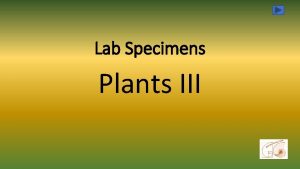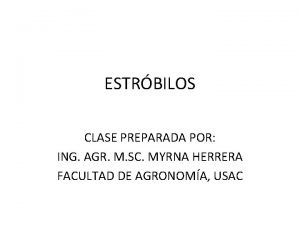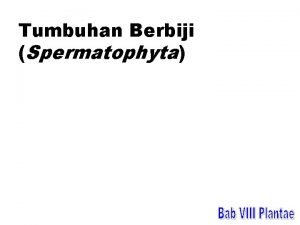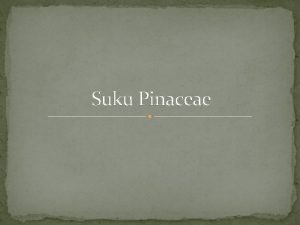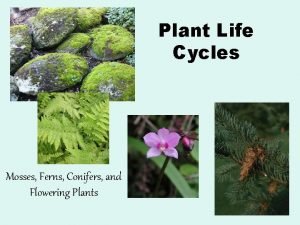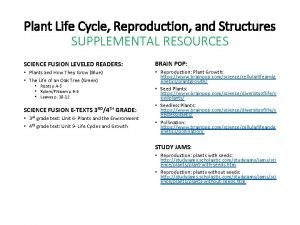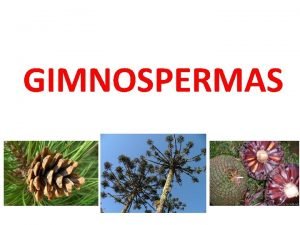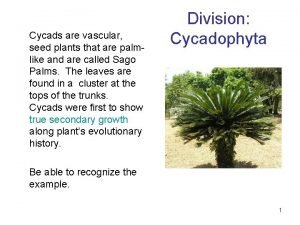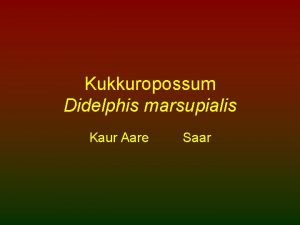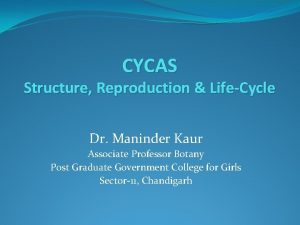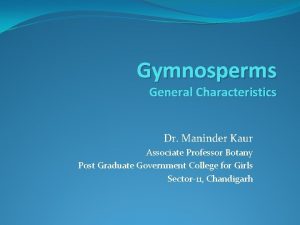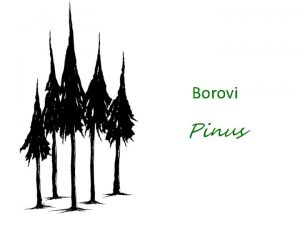Pinus Structure Reproduction LifeCycle Dr Maninder Kaur Associate






























- Slides: 30

Pinus Structure, Reproduction & Life-Cycle Dr. Maninder Kaur Associate Professor Botany Post Graduate Government College for Girls Sector-11, Chandigarh

Systematic Position �Gymnospermae • Division: Coniferophyta � Class: • Coniferopsida Order: Coniferales • Family: Pinaceae �Genus: Pinus

Occurrence & Distribution �Widely distributed in the Northern Hemisphere �Of the 75 species, 6 species are Indian �P. excelsa, P. longifolia, P. gerardiana, P. insularis, P. armandi �Forms dense evergreen forests in hilly regions (Himalayas)

Sporophytic Plant Body �Adult plants are tall trees up to 200 feet in height �Perennial, xerophytic plants appearing pyramidal or conical due to radial branching �Branches are dimorphic – long shoots and dwarf shoots (spurs) �Leaves are dimorphic – Scale leaves and green acicular leaves �Male and female cones present on the same plant, hence monoecious

External Morphology – Stem �Erect, tall, cylindrical, woody and branched �Branching monopodial and excurrent �Lower branches longer and horizontal giving the conical shape to the plant Pinus -trunk

External Morphology – Stem �Branches of unlimited growth are the long shoots �Arranged spirally around the main trunk �Bear scale leaves and dwarf shoots in axils of scale leaves �Branches of limited growth or dwarf shoot lacks apical bud �Possess 8 -10 spirally arranged scale leaves terminating into 1 -5 needle like foliage leaves at apex

External Morphology – Leaves �Scale leaves thin, brown and small �Main function is to protect young buds & conserve water around the branches �Foliage leaves are long & acicular (needle like) �Remains green for a number of years (3 -10 yrs) hence plants are evergreen �No. of needles per spur varies from 1 -5 with species (monofoliar to pentafoliar)

External Morphology – Root �Plant possesses tap root �Elongated structure with strong lateral branches �Root-hairs scanty; function taken up by ectotrophic mycorrhiza (fungus roots) �It is symbiotic association of fungal mycelium on the root’s surface �Helps in absorption of nutrients & protection from pathogens �Fungal species identified are Rhizopogon, Amanita, Boletus, Entoloma, etc. – mostly members of Basidiomycetes

Anatomy – Root �Resembles typical dicotyledonous root �Piliferous epiblema bear unicellular root hair (seen only in young roots) �Broad parenchymatous cortex follows �Endodermis and pericycle layers seen next �Vascular tissue is radially arranged in 2 -6 groups of xylem and phloem �This tissue lacks true vessels and companion cells �Resin canals present in xylem patch making it Y-shaped �Old roots show secondary growth

Anatomy – Stem �Typically dicotyledonous stem �Cuticularized epidermis encloses the lignified sclerechymatous hypodermal layer below �Inner cortex is thin walled parenchyma containing chloroplasts and resin canals �Vascular bundles are conjoint, collateral, endarch , open and form a ring �Medullary rays are narrow �Vessels in xylem and companion cells in phloem are absent

Anatomy – Stem Pinus – T. S. of Old Stem

Secondary growth in stem �Ring of vascular cambium develops �Remains active each year forming spring wood & autumn wood – annual rings �Important in dendrology for estimation of the age of the plant �Secondary medullary rays usually uniseriate �Pinus wood is dense and massive with few parenchyma cells – pycnoxylic �Cork cambium (phellogen) formed in outer cortical layer �Forms secondary cortical cells (phelloderm) towards inner side and cork (phellem) on outer side

Anatomy – Leaf �Xeromorphic �P. longifolia is trifoliar; so the needle shows triangular outline �Outermost epidermal layer has thick-walled cells which are cuticularized �Stomata are sunken �Hypodermis is sclerenchymatous

Anatomy – Leaf Pinus – T. S. Needle

Anatomy – Leaf �Mesophyll not differentiated further �These cells have peg-like infoldings of cellulose projecting in their cavities �Have a large number of chloroplasts & starch grains �Resin canals with secretory tissue present �Two vascular bundles with conjoint tissue present in the middle Resin Duct

REPRODUCTION �Takes place by means of spores –microspores (male) and megaspores (female). The plants are therefore heterosporous �The male and female cones occur on the same plant, but different branches i. e. monoecious

Male cones (Staminate cones) �Borne on the lower branches in the axils of scale leaves. �Appear in the month of January (in plains) and March (in hills) reaching maturity within 2 -3 months. �Can be seen in clusters just behind the shoot – apex.

Male cones (Staminate cones) �Each cone has 60 -100 spirally arranged microsporophylls �Two microsporangia are present on the underside of each microsporophyll �Development of microsporangium is eusporangiate type �Within the microsporangium, the microspore mother cells undergo meiotic divisions to form haploid microspores

Microspore (Pollen grain) �It is surrounded by a 3 -layered wall �Exine heavily cuticularized on one side of the microspore �Middle layer (exo-intine) projected outwards into two large balloon-like air sacs or wings �Inner layer(intine) is very thin �On maturation the spores germinate in situ. Hence, early gametophytic development is precocious �At the time of dehiscence, huge quantities of microspores form yellow clouds around the pine forests. It’s called the “Shower of sulphur dust” Pollen grains

Female cone (Ovulate cone) �Borne on the upper branches of the tree, in axils of scale leaves either singly or in groups of 2 -4. �Female cones are seen in February and get pollinated within 3 -4 months �Complete maturation and seed dispersal takes place in the 3 rd year of development In Longitudinal Section

Female cone (Ovulate cone) �Each cone consists of central axis bearing spirally arranged ovuliferous scales (60 -70) �On young cones a small thin & leathery bract scale can be below the ovuliferous scale �Each ovuliferous scale has two ovules on its upper surface �Cone on maturity is usually cylindrical and 15 -20 cms in length

Megasporophyll �The ovuliferous scale is thick, large, woody & brownish structure �More or less triangular in outline – broad, terminal portion is apophysis with its centrally projected area – the umbo �Basal portion is narrow and bears two naked, sessile anatropous ovules on its upper surface

Ovule Structure �Micropyle of the ovule faces the central axis of the cone �The single integument is fused to the nucleus except for a short distance near the micropyle �Embedded in the nucellus , the archesporial cell divides meiotically to form four megaspores

Female Gametophyte �The inner most functional megaspore further gives rise to the haploid female gametophyte tissue wherein the archegonia develop. �The venter of the archegonia contains the upper ventral canal cell and the larger egg cell.

Male Gametophyte �Early development takes place inside the microsporangium �Pollen grains are released at the 4 -celled stage (2 prothalial, a generative cell and tube cell) �Pollination is anemophilous and pollen reach the pollen chamber of the ovule through micropyle

Male Gametophyte �Further development here, results in the formation of pollen tube which carries the two unequal male gametes to the neck of the archegonium �The released male gametes will fertilize the egg cell resulting in zygote formation �Time gap of 12 -14 months is seen between pollination and fertilization

Young Sporophyte �Embryo development is meroblastic �In early stages the embryonal tier of the proembryo splits apart forming 4 apical segments each with its suspensor �Each of these terminal embryonal cell give rise to a mature embryo, thus Cleavage polyembryony is observed

Seed Structure �Seeds are naked (not enclosed in fruit) �Seeds are winged – the latter being derived from portion of upper surface of the ovuliferous scale �Outer fleshy layer of ovule disintegrates �Testa formed from the middle stony layer �Tegmen is the inner fleshy layer of the ovule �Nucellus is almost consumed during embryo development. �Remnants of nucellus , at micropylar end can be seen as reddish papery structure – the perisperm

Seed Structure �The haploid female gametophyte surrounding the embryo forms the oily white kernel (edible part). �Mature embryo has the radicle towards the micropyle and plumule away from it. �Plumule is surrounded by 8 -14 cotyledons, which are green in colour. �Germination is epigeal.

Thank you
 Advantage of hybrid topology
Advantage of hybrid topology Meaning of maninder kaur
Meaning of maninder kaur Isolasi ekogeografi adalah
Isolasi ekogeografi adalah The disadvantages of sexual reproduction
The disadvantages of sexual reproduction Asexualk
Asexualk Sexual and asexual reproduction in animals venn diagram
Sexual and asexual reproduction in animals venn diagram Introduction of pinus
Introduction of pinus Pinus staminate cone
Pinus staminate cone Salmo abanticus pinus nigra
Salmo abanticus pinus nigra Salmo abanticus pinus nigra
Salmo abanticus pinus nigra Estróbilo
Estróbilo Pinus strobus nana
Pinus strobus nana Buatlah peta konsep klasifikasi tumbuhan
Buatlah peta konsep klasifikasi tumbuhan Vignaceae
Vignaceae Ferns and conifers
Ferns and conifers Parts of a flower quiz
Parts of a flower quiz Ciclo de vida de um pinheiro
Ciclo de vida de um pinheiro Batang
Batang Pinus staminate cone labeled
Pinus staminate cone labeled Roopreet kaur
Roopreet kaur Mata bhag kaur
Mata bhag kaur Gulnaz kaur
Gulnaz kaur Adhesiivinen kuluminen
Adhesiivinen kuluminen Jasleen kaur unc
Jasleen kaur unc Raj kumari amrit kaur coaching scheme
Raj kumari amrit kaur coaching scheme Didelphis
Didelphis Kaur kaasik
Kaur kaasik Kaur kajak
Kaur kajak Pam kaur hsbc signature
Pam kaur hsbc signature Kaur aare saar
Kaur aare saar Rani sahib kaur
Rani sahib kaur







